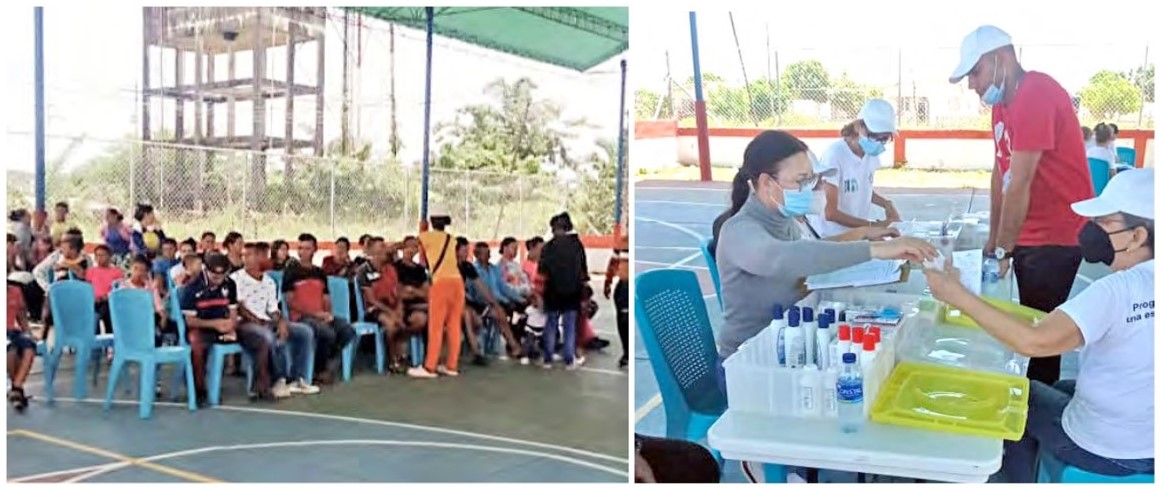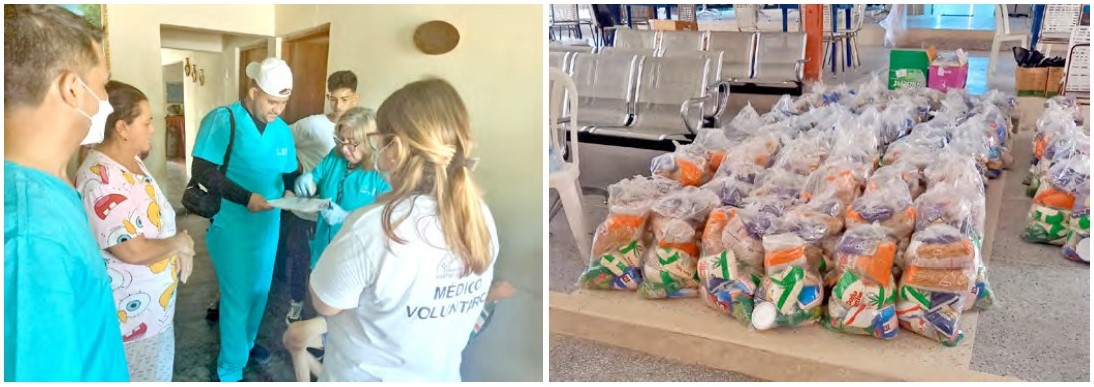
Current HD Care in Venezuela
Highlight from the: EHDN Newsletter_Mar2024_Issue51
Alex Fisher, Senior Occupational Therapist, Birmingham and Solihull Mental Health NHS Foundation Trust
Armed with school-level Spanish, Google translate, and the goodwill of her new colleagues and friends, in September 2023, Alex Fisher became the first foreign healthcare professional to join Factor-H in visiting the Venezuelan communities. She shares with us her thoughtful reflections on the trip.
Four hours from crumbling Maracaibo (the State capital), riding in a second-hand bus from China packed to the gills with food parcels, medical professionals, and humanitarian personnel, I’m here with Factor-H and Habitat Luz. These two organizations work together to provide advocacy and humanitarian aid for impoverished HD communities throughout Latin America. Habitat Luz provides an administrative and operative arm focusing on Venezuela and the townships of San Francisco, St Luis, and Barranquitas. Ten percent of the remaining population in these areas have HD. I say ‘remaining’ as migration from Venezuela has been upwards of 7 million since 2015.
Whilst the HD families of St Francisco and St Luis live in perilous circumstances, being on the city’s edge at least gives them access to piped (if not clean) water. Barranquitas does not have this luxury. So, alongside the abandoned infrastructure courtesy of a divided and detached government, I join in the collective cries of ‘La Luz’ (meaning ‘the light’) when the electricity returns from its daily outages.
Sore from the roller coaster ride of the immense potholes on our journey, we stretch and step out into a space where trestle tables are being laid out under the cover of a basketball court and see an increasing throng of families waiting. I dodge a motorbike that pulls up loaded with four people, two of whom with profound chorea are sandwiched between the driver and rear pillion passenger. This is an outpatient clinic, but not as we might know it. It’s (usually) a three-monthly visit by the teams, which combines the delivery of foodstuffs to HD families, educational and fun materials for the under 12s, and symptom check-ups and advice for everyone, provided by Factor-H and Habitat Luz.

The outpatient clinic is overseen by two (volunteer) neurologists and a paid GP (via Factor-H). Whilst volunteer medical students work alongside Habitat Luz local volunteers in the clinic, Dr Aura and Dr Soto head out on home visits to those who can’t attend the clinic, having been advised of the need by Yoliz (Factor-H’s Resident Social Worker).
We attend a home visit, driven by Samuel (Factor-H’s local ‘fixer’). The family structure and societal norms mean that as we make our way into people’s homes, neighbours and interested parties appear, too. I make mental notes on the environment, how care is delivered, and ask permission to return.
Usually, the three-monthly visit to Barranquitas takes place over two days, with the teams either returning to their homes or repairing to a hotel in the prefecture’s capital. However, the rainy season has better ideas, and Samuel receives news that the roads are flooded. With our precious cargo and the bus with its frayed tyres, it is too risky to attempt. Disappointed but not bowed, Marina (President of Habitat Luz) takes the opportunity to engage with the Prefecture’s Mayor. Land purchased by Factor-H for a future project called Casa Dignidad (a dedicated day centre) in Barranquitas has been stolen and built on. The Mayor is sympathetic and agrees to explore what had happened (I later hear that he was good to his word, and in November, an alternative site was earmarked).

I return to Barranquitas for four days and stay in the bosom of Atalina and her family, whose home is next to the Factor-H/Habitat Luz office. I’m bunking in the same room as Yolis while Samuel and Gindel (a Caracasbased documentary maker/journalist and my translator) sleep in the office.
Marina has asked me to support a project to improve caregiver well-being. Meeting with the local team, it soon became clear that my prepped list of what we thought the community needed and what they actually wanted was poles apart.
Focusing on the community and the conditions in which they live, we set out to interview and film the stories of individuals. This created a natural, iterative foundation for ‘The Cuidadores (Carers) of Barranquitas’ project. First, we meet Selina, to whom Gindel brings joy through dancing, and we try to decipher what has happened to her belongings through the buzz of mosquitoes and the many voices of her neighbours. Crime is close at hand here, and her two sons, both of whom appear to have HD, may have sold the furniture for drugs but also for survival, leaving her only with a string chair, a hammock, a dirty mattress, and her cat. Despite her sons masquerading as her carers, it is the community and her sister-in-law who tend to her. While clearly a very serious issue, reaction requires processing, and intervention has ramifications for Selina’s safety. Both organisations have a humanitarian drive, and that’s about equity of delivery which does not cause tensions elsewhere.
Onwards, we meet Olga and Maria and, later, Jorge, a homeless man with HD with three affected brothers in the same position. Jorge, sleeping in an old school building, is being fed by a number of ladies who ask us for more information on his condition and how to help. Despite their own desperate circumstances, the compassion is genuine.
Over the next few days, we continue to collate the stories of people’s daily lives. As an HD professional in the UK, I meet suffering and inspiration in equal measure, but here it is magnified. On one of our last visits, Gindel draws me into a darkened room. As my eyes adjust, I see that I am surrounded by four moving bodies in varying stages of their illness. Although initially stunned, I am struck by the tenderness with which these people are cared for by a young man. Jesus cares not only for his father but also his two aunts and uncle. He knows he, too, is at risk, but his faith consoles him, and in the brief periods of time he has to himself, he reads and tends to the garden at the rear of the house he shares with the family. We watch as he carries
his aunts into the open-air kitchen area, and his grandmother and a friend undertake precision feeding of their loved ones. His uncle, fed earlier, can now not eat fluidly as his rigidity is affecting his ability to open his jaw (and therefore hold and swallow adequate nutrition). I advise Jesus on back care, which may seem trivial but is vital to his well-being. I also advise on feeding his uncle and how to increase his hydration and make a mental note to discuss supporting safer manual handling with Marina.
Silently, we walk back to the Habitat Luz office. There is much to be done, and as we eat together, we share thoughts and plans. There’s one last event: the formation of the new Cuidadores and Volunteers group. We all grab a plastic chair, walk to a nearby lakeside wharf and form a circle next to a group of piglets irritating the more established chickens. We talk about faith and suicide, but mostly about the hope of what we can achieve and love and pile in for many group hugs. On returning to Maracaibo and, for me, to the UK, the teams have been building on the insights and ideas from
the trip. In essence, the hope is to create a greater community of practice which can cater for the current and future delivery of care to these communities to whom we owe so much. Factor-H and Habitat Luz, as well as the patient organisations of Latin America, have formed the vital foundations and framework. But if we are to envisage a time when there will be the equitable delivery of the hard scientific hope of treatment, many barriers remain to be overcome.


